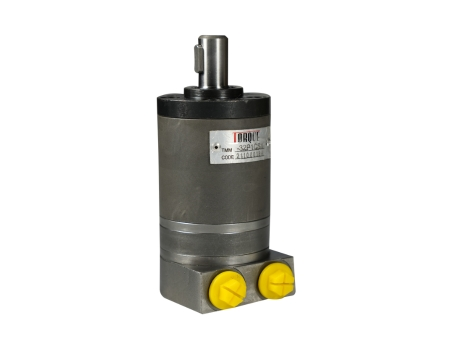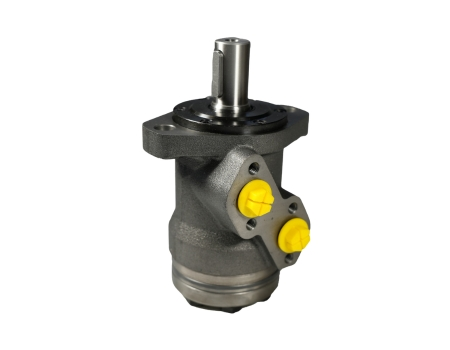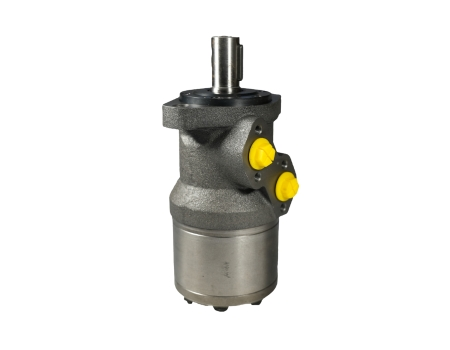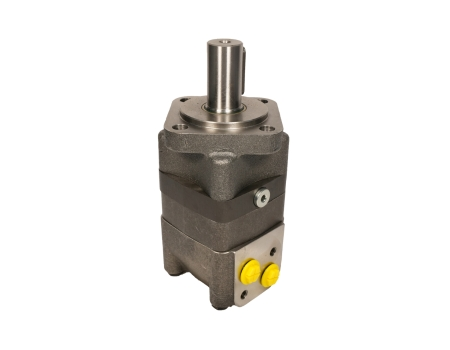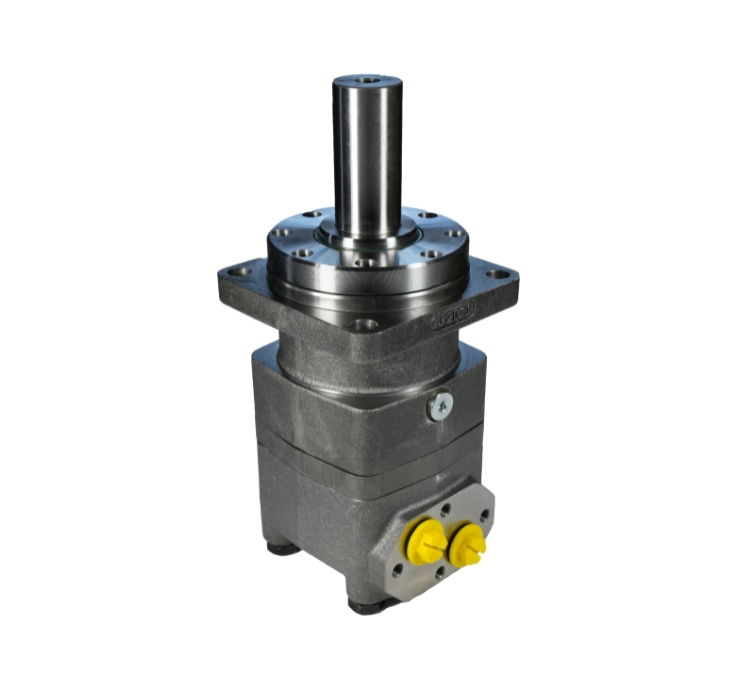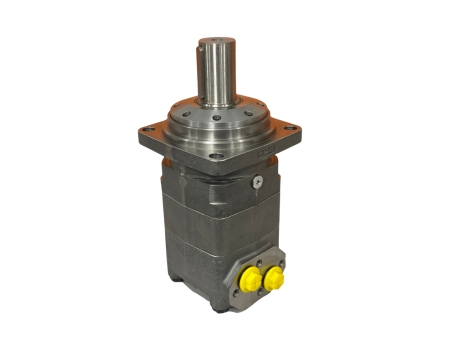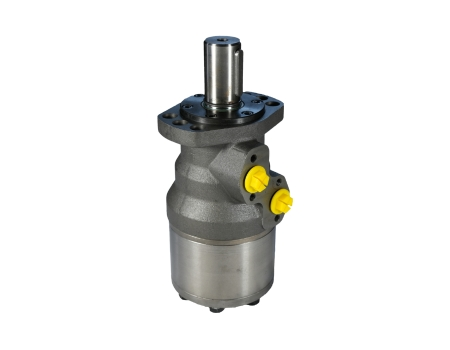Contact : +91-79045 61980 | Email: hydrofitengineers@gmail.com
What are Hydraulic Motors
Hydraulic motors are devices that convert hydraulic pressure and flow into mechanical power or rotational motion. They are essentially the opposite of hydraulic pumps, which convert mechanical power into hydraulic energy
Working Principle of Hydraulic Motors
Working Principle: Hydraulic motors operate based on the principle of converting hydraulic energy (fluid pressure and flow) into mechanical energy (rotational motion). This conversion is achieved by utilizing the force exerted by pressurized hydraulic fluid on internal components within the motor. The fluid enters the motor and applies pressure to pistons, vanes, gears, or other movable elements, causing them to move and generate rotational motion
ZTMR Series Orbital Motor
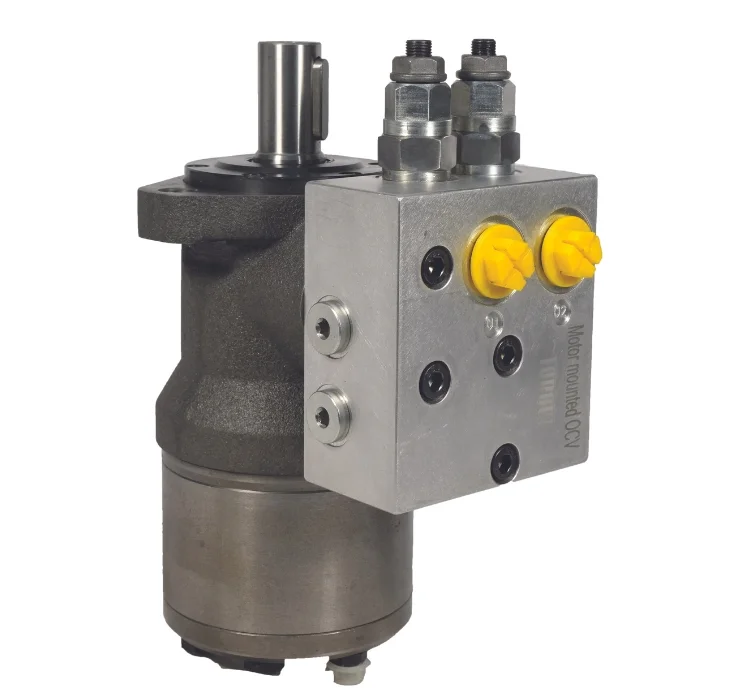
Types of Hydraulic Motors
There are several types of Hydraulic Motors. These include :
1. Gear Motors
These motors use intermeshing gears to transmit power. They are simple and compact but may have lower efficiency and performance compared to other types
- Design: Gear motors consist of intermeshing gears enclosed in a housing with inlet and outlet ports.
- Construction: As pressurized fluid enters the motor, it flows into the housing and forces the gears to rotate. The rotation of the gears transfers mechanical power to the output shaft connected to one of the gears.
2. Vane Motors
Vane motors use vanes mounted on a rotor to generate rotation. They are known for their smooth operation and can provide high starting torque
- Design: Vane motors typically have a cylindrical housing with vanes mounted on a rotor inside. The housing contains ports for fluid inlet and outlet.
- Construction: The rotor is connected to a central shaft, and as pressurized fluid enters the motor, it pushes the vanes outward against the housing. This creates a force that causes the rotor to rotate, transferring mechanical power to the shaft.
.
3. Piston Motors
Piston motors use pistons within cylinders to generate motion. They are capable of providing high torque and power output, making them suitable for heavy-duty applications
- Design: Piston motors consist of a cylinder block with pistons housed inside cylinders. The block contains ports for fluid inlet and outlet.
- Construction: The pistons are connected to a central rotating shaft. As pressurized hydraulic fluid enters the motor, it pushes the pistons outward, causing the shaft to rotate. The design may be axial, where the pistons move parallel to the shaft, or radial, where the pistons move outward from the center of the shaft.
4. Radial Piston Motors
- Design:
- Cylinder Block: Radial piston motors consist of a cylinder block with multiple cylinders arranged radially around a central shaft.
- Pistons: Each cylinder contains a piston that moves in and out in response to hydraulic pressure.
- Valve Plate: The valve plate is located at the center of the cylinder block and contains ports for hydraulic fluid inlet and outlet. It also directs fluid flow to each cylinder in a sequential manner, causing the pistons to move in a synchronized fashion.
- Central Shaft: The central shaft is connected to the pistons and rotates as the pistons move in response to fluid pressure.
- Construction:
- The cylinder block and valve plate are typically machined from high-strength materials such as steel or aluminum.
- Pistons are fitted into each cylinder with seals to prevent leakage of hydraulic fluid.
- Bearings are used to support the central shaft and facilitate smooth rotation.
- Seals are employed throughout the motor to prevent leakage and maintain hydraulic pressure within the system.
5. Axial Piston Motors
- Design:
- Pistons: Axial piston motors have pistons arranged in a circular pattern around a central shaft, with their axes parallel to the shaft.
- Cylinder Block: The cylinder block contains multiple cylinders, each housing a piston.
- Swashplate: The swashplate is a key component in axial piston motors. It is a tilted or angled plate that can be adjusted to vary the displacement of the pistons.
- Valve Plate: Similar to radial piston motors, the valve plate directs hydraulic fluid flow to each cylinder in a controlled manner.
- Central Shaft: The central shaft is connected to the pistons and rotates as the pistons move in response to fluid pressure.
- Construction:
- The cylinder block, swashplate, and valve plate are typically machined from durable materials such as steel or aluminum.
- Pistons are fitted into each cylinder with seals to prevent fluid leakage.
- Bearings support the central shaft and ensure smooth rotation.
- Seals are used throughout the motor to maintain hydraulic pressure and prevent leakage.
Common Features of Radial Piston and Axial Piston Motors
- Both radial and axial piston motors rely on the reciprocating motion of pistons to generate rotational motion.
- Bearings are essential components that support the rotating shaft and minimize friction.
- Seals are used extensively to prevent leakage of hydraulic fluid and maintain system efficiency.
- Both types of motors can offer high efficiency, precise control, and high power density, making them suitable for a wide range of industrial applications.
Radial and axial piston motors are key components in hydraulic systems, offering efficient and precise conversion of hydraulic energy into mechanical power for various industrial applications. Their designs may vary, but they both utilize pistons to generate rotational motion.
Applications of Hydraulic Motors
Hydraulic motors find applications in a wide range of industries and machinery where rotational motion is required
Construction Equipment
Hydraulic motors are extensively used in construction machinery such as excavators, bulldozers, loaders, and cranes. They power functions such as driving wheels or tracks, rotating the boom, operating hydraulic arms, and driving winches for lifting heavy loads
Agricultural Machinery
In agricultural equipment like tractors, combines, and harvesters, hydraulic motors power various functions such as driving wheels or tracks, operating implements like plows and tillers, and controlling hydraulic systems for steering and lifting
Marine Equipment
Hydraulic motors are crucial components in marine applications, powering propulsion systems, winches, cranes, steering mechanisms, and other equipment on ships, boats, offshore platforms, and dredging vessels
Material Handling Equipment
Hydraulic motors drive a wide range of material handling machinery, including conveyor belts, forklifts, pallet jacks, and automated sorting systems in warehouses, distribution centers, and manufacturing facilities
Industrial Machinery
Hydraulic motors are used in various industrial applications, including machine tools such as lathes, milling machines, and presses, as well as in metalworking equipment like shears, bending machines, and stamping presses
Automotive Applications
Hydraulic motors are employed in automotive systems such as power steering systems, where they assist in turning the vehicle’s wheels, and hydraulic braking systems, where they amplify the force applied to the brakes
Mining Equipment
Hydraulic motors power machinery used in mining operations, including drilling rigs, excavators, rock crushers, and conveyor systems for transporting ore and materials in mines and quarries
Forestry Equipment
Hydraulic motors are utilized in forestry machinery like log splitters, wood chippers, and forestry harvesters, where they power cutting and processing equipment, as well as hydraulic systems for manipulating logs and trees
Aerospace Industry
Hydraulic motors are employed in aircraft and aerospace applications for functions such as actuating landing gear, controlling flight surfaces like flaps and slats, operating cargo doors, and controlling hydraulic systems in aircraft engines
Energy Sector
Hydraulic motors play a role in various energy-related applications, including powering hydraulic systems in renewable energy generation equipment such as hydroelectric turbines and wind turbine pitch control systems

